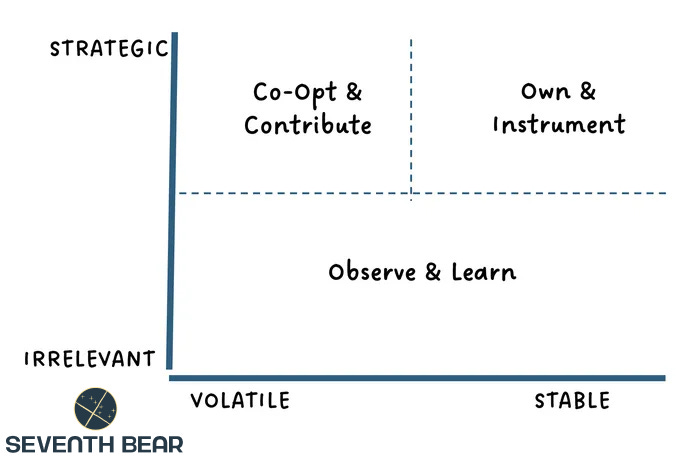IHappy Independence Day, friends!
I don’t know about you, but this week has me reflecting on America’s original content creators – the Founding Fathers. “Join, or Die”? Viral infographic. “We hold these truths”? Killer positioning statement.
Today, Ben Franklin would absolutely be running a Substack called Frankly Speaking, dishing enlightenment-era hot takes with a side of electricity puns. You know, the current stuff… <I’m sorry>…
George Washington definitely launches a podcast called “Crossing Streams”. And Jefferson? Let’s be honest – he’d be ghostwriting blogs for Silicon Valley tech bros. The latest gig? Drafting OpenAI’s ‘New Enlightenment Manifesto’ – now with 20% more hallucination.
Anyway….
So – speaking of marketing tech bros – it seems like there’s a ton of talk on my doom scroll about AI Search Optimization (AEO it’s called). It’s supposed to be the next frontier that we’re supposed to master.
I have….. thoughts…
So, let’s slow down and think about this like it’s the TV show The Bear: There might be value – but only if someone finally stops yelling long enough to taste the sauce.
In this episode of LENS:
- Zoom Lens: Congratulations! You’re An Answer. Now What?
- Wide Angle Lens: What Is Marketing Anyway?
- Lens Flare: Getting Ahold of Our Content
- Let’s roll….

ZOOM LENS: Congratulations, You’re An Answer. Now What?
Are We Really Doing This Again?
There was a time – about twenty years ago – when we all decided (not in a meeting, but somehow collectively) to hand all our content over to Google. At their suggestion, no less. And not just hand it over – we spent our own hard-earned pocket money to make it tidy: tagging, structuring, categorizing. We made it as easy as possible for them to take our ideas, index them, and store them in a nice, algorithm-friendly format. So convenient.
The promise? You’ll be found.
And for a while, we were. Until – well – we weren’t. Oops, panda, hummingbird, kangaroo or whatever other Farm Animal Google Search updates became just part of the territory. Slowly, the “being found” part got eroded to make room for “you can pay… to be found.”
Okay. Lesson learned.
But wait – nope – we did it again about ten years later.
There was another moment. Again, no formal meeting – or chicken dinner – but plenty of very passionate keynote speakers. We all decided to give it away again – this time to the social media platforms. They shouted, “Build our business model – ahem – we mean, your community!” They promised, “We’ll be your town square!”
That one went so far that we genuinely considered giving up our websites in favor of Facebook pages. Sounds absurd now, but at the time? It felt like progress. “Go where the audiences are,” they said.
The promise? Your customers, reached and engaged.
Until – yep – that stopped working too.
Okay. Now we’ve learned, right?
…Or have we?
Because here we are again. Only this time, the new promised land isn’t social. It’s generative AI. Specifically, it’s being the “answer” in AI search.
We’re told we need to optimize for Perplexity, ChatGPT, Google’s AI Overviews – anywhere a language model might (if we’re lucky) cite our content in its response. Citation dashboards, “prompt share,” “LLM visibility scores” – all the hallmarks of a fresh marketing gold rush. New tools, new metrics, same old promise: get there early and win big.
And yes, there’s no question AI is changing how people search for and interact with information. According to some reports, over 13% of desktop queries in the U.S. now generate AI summaries. Some publishers are seeing traffic cuts of 50% or more. This is happening.
But let’s pause before we assume we need to pour our content into yet another machine.
Because if this all feels familiar – it should.
To be clear, the question isn’t whether AI matters. It clearly does.
The question is: what are we optimizing for?
Are we trying to be cited by a machine – knowing full well that those citations are ephemeral, inconsistent, and largely unclicked? Are we helping LLMs become more accurate – while simultaneously undercutting our own ability to build audience, trust, and traction?
Or can we take a different path this time?
I definitely don’t have an answer for that yet. Purposely. Because this time, maybe we could just take a breath and think this through a bit.
I’ve been playing with a bit of a simple matrix (as one does LOL) that I’m calling the Brake Check:

Which questions truly matter to your business? How volatile are the AI-generated answers? If it’s high relevance and low volatility – great. That’s where you own the answer. Instrument your content accordingly. Make it easy to find, easy to update, and unmistakably yours.
If it’s high relevance but high volatility – don’t try to out-Google the internet. Instead, co-opt the ecosystem. Publish where AI already pulls from. Get cited by proxy. Partner with the sources that have gravity. Create content that lives within the stream, not just upstream from it.
And if the questions aren’t relevant to your goals? Learn from them. Observe. Watch what content LLMs prefer, who’s showing up often, and where you’re absent – by design.
Most importantly: invest in your owned experiences. Give people a reason to step past the velvet rope. Make your newsletter, your blog, your research – the place where answers don’t just show up, but make people stay. Spoiler alert: this is the part where I’m wrestling the hardest these days.
There’s no first-mover advantage here. No “land grab” to win.
The brands that thrive won’t be the ones who publish the fastest – they’ll be the ones who publish with purpose. The ones who know when to show up, when to speak up, and when to hold something back.
The best answers, after all, don’t come from machines.
WIDE ANGLE LENS: WHO’S LINE IS IT ANYWAY?
Let’s get it all in focus, shall we?
🧠 ICYMI: When a Brand Goes Quiet
Last week, Intel announced it’s outsourcing its entire marketing function—not just media buying or creative execution, but the whole function – to Accenture and AI.
No in-house brand team. No internal strategy group. Just consultants and code.
At first glance, this feels like a cost-cutting move and an awful idea. (It is. But it may not be). Layoffs are involved. Efficiency is cited. ROI spreadsheets are surely humming, and I would hazard a guess that there are more PowerPoint decks floating around now than there are people to read them. But there’s something deeper going on here – something worth pausing on.
Intel isn’t just trimming fat. It’s declaring a new identity.
And that identity isn’t built on differentiation. It’s built on survival.
Intel used to be one of the few tech brands regular people actually knew. It was a trusted name, a performance flex, a signal of quality in a sea of specs. Now? They’re effectively saying: “You don’t need to know who we are anymore. You just need to know we exist.”
And that’s the real story.
Intel is making a conscious strategic retreat from brand as advantage. They’re no longer trying to lead, inspire, or even stand out. They’re trying to optimize, scale, and last. This is the corporate equivalent of the “this is my life now” meme.
So – I don’t think this a bad strategy at all. It’s just a smart, sad one.
🤖 LENS FLARE: Nobody wants to collaborate – until they do.
A recent lesson learned from one of our latest client engagements:
Not long ago, we worked with a legacy organization where something quietly dangerous was happening: the 20-year veterans – the deep subject matter experts – were leaving, and the next generation of marketers, product managers, and media leads were stepping in… without a roadmap.
No institutional learning. No content libraries. No internal knowledge sharing. The veterans thought the newbies weren’t curious. The newbies thought the veterans weren’t accessible. Everyone kept working, but the smart stuff – the stuff that made this company great – was quietly leaking out the back.
We built an internally focused content strategy: one that prioritized collaboration, structured knowledge sharing, and made “building the next generation of experts” a strategic priority.
The funny thing? People say they want to collaborate – but they don’t really want to collaborate. Not until you give them a structure that quietly demands it. Then they do. Then they start learning. Then the work gets smarter.
Sometimes, you have to force collaboration… just long enough for people to realize they actually want it.
If we can help you force a little collaboration – let us know.
LENS CAP: FINISH WITH A FLOURISH
🍷 Finishing Notes…
So this weekend as you munch on a hot dog, sip something cold, and watch the fireworks paint the sky – take a breath.
Think about where you’re placing your bets. Are you chasing AI and Answer Engine Optimization because it’s strategic… or because it’s loud? If you’re being pressured to rush it…. ask… Why what’s the rush?
Maybe next week – start a conversation with someone in your org you haven’t collaborated with in a while. Or ever. See if you can’t force a little brilliance into the room.
And when it comes to your brand – ask yourself: Are you trying to show you’re different, or just hoping that people know you exist?
Neither is the wrong choice. But if you haven’t made the first one on purpose, well – you’ve already made the second by default.
Happy Independence Day. Whatever you do – just always make it seem you meant to.
It’s Your Story. Tell It Well.